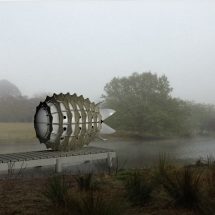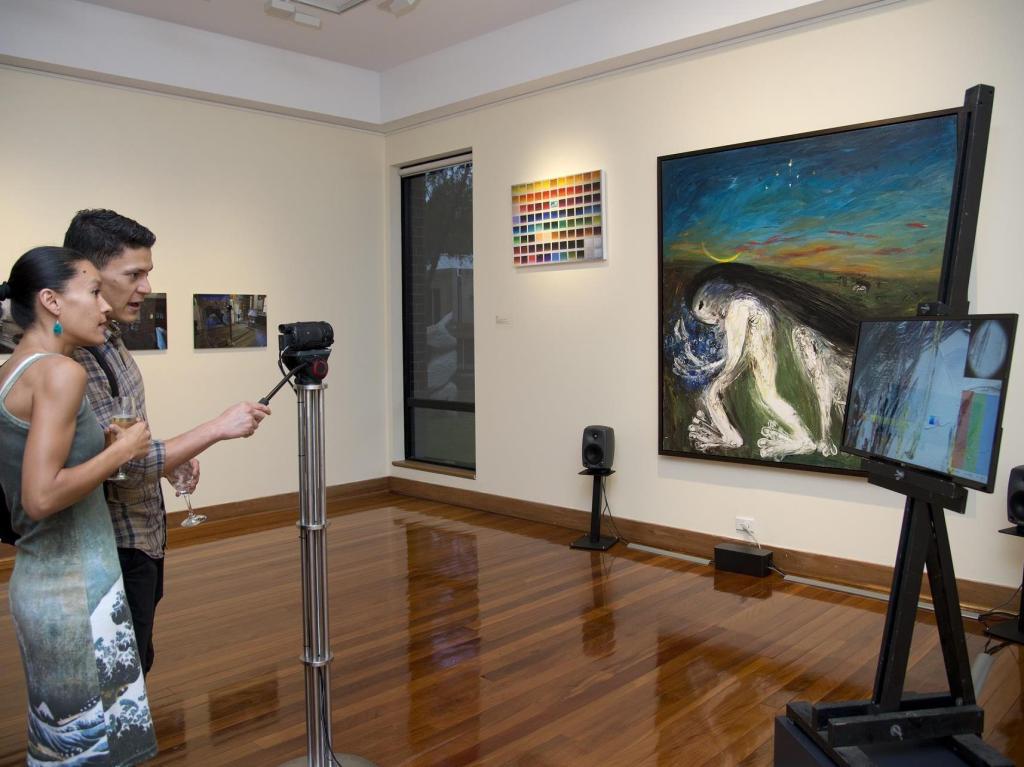Heavy Metal (2016) installation at Macquarie University Art Gallery. Image supplied.
Nigel Helyer describes his intrigue at the links between Arthur Boyd living in the Bundanon landscape, painting its physical features and using pigments made from its mineral deposits as completing a ‘metaphorical circuit’. This is also a perfect description of the experience of Landscape/Portrait exhibition, an exploration of the Shoalhaven River Valley, at Macquarie University Art Gallery.
The Landscape/Portrait exhibition documents the artworks produced as part of an ARC funded research project When Science Meets Art, part of a series of contributions to the consecutive Siteworks program at Bundanon in 2013-2016. It’s a truly multi-disciplinary collaboration and a truly mind-boggling collection, and connecting of evidence: images, minerals, water, sounds, poetry, archives, archaeology, digital codes. It’s a daunting task for the curators, Nigel Helyer and John Potts, to represent all elements in an exhibition – and for the visitor to decipher. But as artists, scientists, bushwalkers and exhibition-goers know, curiosity is always rewarded.
The exhibition is refreshingly unpredictable, part gallery with framed works on white walls, part domestic interior with Persian rugs, part bivouac with tents and boats, part laboratory, studio, shed. A series of screens When Science Meets Art provides concise video essays that orient the projects and their Bundanon context.
Most projects are documented by large photographs of the original installations. These are great images of the site-specific projects. In Milk and Honey (2013) two sonic punts ‘floated’ in the Bundanon homestead music room carrying cargoes of milk and honey to a new home in the bush. BioPod_V02 Nebuchadnezzar suite (2015) photographs the series of ‘feral’ sculptural forms ‘inhabited’ by Siteworks participants, seeming to be out of place like the outcast king Nebuchadnezzar –and us today.

Nigel Helyer and Duncan Bond, Biopod, 2014, 3D visualisation. Courtesy the artists and Macquarie University Art Gallery.
BioPod_V01 (2014) has a strong physical presence in the exhibition. At Bundanon participants were invited to sleep in a tent floating on the lake and make recordings of their experience as a means to facilitate active listening in the environment. In the gallery, visitors can pass the floating skiffs to occupy the tent with its eerie recordings and nocturnal imaginings.
Heavy Metal (2016) translates best from site to gallery because it is the most fully-realised artwork. This work eloquently links several parallel investigations. Environmental scientist, Mark Taylor, extended his methodology of surveying the minerals in soil as traces of past human activity to analyse the mineral composition of pigments in Boyd’s painting. Heavy Metal maps the painting by correspondences of minerals and colour palette. Working with Helyer, Jon Drummond, a data sonification expert, linked sounds from the Steinway piano at Bundanon homestead, Boyd’s colour palette and the translation of the stream of mineral data into sound. A computer screen displays the painting site, colour ratios and a graphic and sonic display of the detected minerals. The viewer can change the sound composition by moving the camera trained on the painting. This could be the first time we can hear the mesmerising sound of a painting’s composition. This was an evocative experience in its initial siting in Boyd’s Bundanon studio. The reconstructed installation in this exhibition remains a powerful experience, especially with the loan of Boyd’s original painting Nebuchadnezzar with blue flowers and white dog (1968) from the Bundanon collection. Again outcast king Nebuchadnezzar appears as a powerful symbol for Helyer as it was for Boyd.
Footprints and Fingerprints (2017) is Helyer’s development ‘sketch’ for the anticipated media rich mapping of the Bundanon site. A giant painted landscape of Bundanon is overlaid with paper cards of mineral data marking each sample site. This is probably the least resolved part of the exhibition, for while heavily applied paint is Boyd’s forte, it’s not Helyer’s. But this is a work in progress and augers an exciting prospect for the remaining ‘portrait’ of Bundanon to unfold.
Sound is a pervasive presence through the exhibition. This is not surprising from Dr Sonique, the creator of marvellous sonic objects. For Helyer, place soundings not only record empirical data but call up the spirits of an archaic memory producing a unique sonorous landscape. There are many resonances here between Boyd’s mythic imaginings and Helyer’s poetics.
The exhibition almost overwhelms with multiple metaphors and data, the twin arms of art and science. Much environmental art does not go beyond metaphor, just as much environmental science does not go beyond data collection. But this project is different in two significant ways. It makes a meaningful engagement with the place of Bundanon, and a meaningful engagement with interpretation and communication through the exhibition medium. An exhibition, like a landscape, is revealed through the experience of moving through it with all the senses alive to its shifting shapes and moods. It’s a wonderful feeling when curiosity, observation and interaction are rewarded – the ‘metaphorical circuit’ becomes a circuit of imagination and knowing.
This is a remarkable forensic portrait of a landscape – from the inside out – bones, nerves, sinews, chemicals, fluids, thoughts, emotions, heartbeats – and yes spirits.
Rating: 4 stars out of 5
Nigel Helyer: Landscape/Portrait
An exploration of the Shoalhaven River Valley
Macquarie University Art Gallery
1 March – 30 April 2017





